 I have a confession to make. I LOVE roller coasters! And I’ll try almost anything once. Yesterday, Dave and I enjoyed a day at Busch Gardens in Williamsburg, Virginia, and spent most of it riding the thrill rides. It’s great to have a partner who appreciates them as much as you do. Busch Gardens is one of my favorite parks, stemming from when we lived in Norfolk and had season tickets. It was our go-to place as our children grew up, but it has been many years since we lived in the area.
I have a confession to make. I LOVE roller coasters! And I’ll try almost anything once. Yesterday, Dave and I enjoyed a day at Busch Gardens in Williamsburg, Virginia, and spent most of it riding the thrill rides. It’s great to have a partner who appreciates them as much as you do. Busch Gardens is one of my favorite parks, stemming from when we lived in Norfolk and had season tickets. It was our go-to place as our children grew up, but it has been many years since we lived in the area.
The oldest amusement park is considered to be Bakken in Kampenborg, Denmark. Located just north of Copenhagen, it was founded in 1583 as a natural spring that attracted visitors who sought the health benefits of the water. Soon, vendors and entertainers began setting up nearby, eventually leading to a full-fledged amusement park. Today, Bakken offers a variety of entertainment and rides and features Rutschebanen, a wooden roller coaster that opened in 1932. How did I not hear of this when we visited Copenhagen?
While we lived in Europe, Dave and I went to a few parks and thoroughly enjoyed the time we spent, especially the Prata in Vienna, Austria. In 1766, Emperor Joseph II opened his hunting ground to the public. And in the early 19th century, Wurstelprater opened as an amusement park. Today, it ranks among the oldest in the world. Dave and I rode several of the coasters and checked out the haunted houses that truly scared us. But the main event at the Prater is the Wiener Riesenrad, a giant Ferris wheel built in 1897. It stands 212 feet high and provides impressive views of the city.
Joseph II opened his hunting ground to the public. And in the early 19th century, Wurstelprater opened as an amusement park. Today, it ranks among the oldest in the world. Dave and I rode several of the coasters and checked out the haunted houses that truly scared us. But the main event at the Prater is the Wiener Riesenrad, a giant Ferris wheel built in 1897. It stands 212 feet high and provides impressive views of the city.
The predecessors of modern roller coasters can be found in the gravity-driven rides in Russia during the 17th century. Wooden slides were laid down and covered in ice, forming a hill for people to ride down. By the 18th century, the French were building wheeled cars and rolling them down hillsides. Les Montagnes Russes (the Russian Mountains), a ride developed in France in the early 19th century, featured a sled-like vehicle on a track, the first gravity-driven roller coaster in the modern sense.
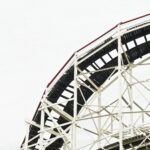 In the United States, the fever for thrill rides began with the opening of the Mauch Chunk Switchback Railway in Pennsylvania in the 1820s. While it was designed to transport coal down a mountainside, passengers soon learned they could enjoy the excitement of the return trip uphill, and the journey became a tourist attraction. Innovation exploded, and new designs evolved rapidly.
In the United States, the fever for thrill rides began with the opening of the Mauch Chunk Switchback Railway in Pennsylvania in the 1820s. While it was designed to transport coal down a mountainside, passengers soon learned they could enjoy the excitement of the return trip uphill, and the journey became a tourist attraction. Innovation exploded, and new designs evolved rapidly.
Roller coasters reached their peak in the early 20th century with iconic rides like the Cyclone at Coney Island. However, the Great Depression, followed by World War II, caused a sharp decline in construction and the money required to visit amusement parks.
While early coasters were constructed of wood, the post-war era saw advancements in design, and steel became the material of choice because of its durability and the opportunities it provided for loops and corkscrews. With the opening of Disneyland in 1955, featuring The Matterhorn, followed by Six Flags in 1961, the era of modern thrill rides began. This search for the ultimate thrill continues today.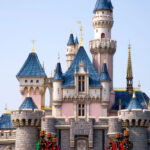
Some brief statistics as of today:
The tallest is Kingda Ka at Six Flags Great Adventure in Jackson, New Jersey, at 456 feet/139 meters. This height enables it to have the longest drop, at 418 feet/127 meters. Wow!
The fastest is Formula Rossa at Ferrari World in Abu Dhabi, which reaches a maximum speed of 149.4 mph/240 km. That’s fast! It uses a hydraulic thruster to achieve 0 to top speed in 4.9 seconds.
The longest is Steel Dragon 2000 at Nagashima Spa Land in Kuwana, Japan. It stretches 8,133 feet/279 meters. That’s more than twice the length of some of my favorites.
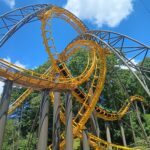 However, Busch Gardens, Williamsburg, is the home of The Loch Ness Monster, the best roller coaster in my humble opinion. I’ll admit, I have a soft spot in my heart for this one, having first ridden Nessie in 1983. She was my first looping coaster. The Loch Ness Monster offers all the thrills: steep drops, loops, and plenty of air time. What is air time? This is when you fly out of your seat and hang momentarily suspended in the air.
However, Busch Gardens, Williamsburg, is the home of The Loch Ness Monster, the best roller coaster in my humble opinion. I’ll admit, I have a soft spot in my heart for this one, having first ridden Nessie in 1983. She was my first looping coaster. The Loch Ness Monster offers all the thrills: steep drops, loops, and plenty of air time. What is air time? This is when you fly out of your seat and hang momentarily suspended in the air.
While I love coasters, I am not one of those who travels the world riding them and can quote each ride’s statistics. Here is what you can find at Busch Gardens, Williamsburg:
Loch Ness Monster: Based on the mythical figure who is said to inhabit Loch Ness in Scotland, the theme begins as you file through the queue and continues as you enter the belly of the beast. The ride opened in June 1978 and was the first to feature interlocking loops. And Nessie has two of them. When it opened, it was the tallest and fastest in the world. Today, its height of 130 feet/40 meters seems modest, but it still provides all the thrills you’d expect, starting with the initial drop of 114 feet/35 meters toward the river.
Alpengeist: This is another of my favorites, though; in this one, the rider is suspended under the track with no floor. Like Nessie, it is named after a mythical creature, the legendary snow beast. When it opened in 1997, it was acclaimed as the most insane roller coaster in the world. Over its run, the rider hits 67 mph/108 km with a drop of 170 feet/52 meters and experiences six inversions, including a cobra roll.
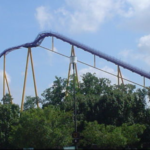 Apollo’s Chariot: While Nessie is a looping coaster, Apollo’s Chariot provides its thrills by flying over a series of hills and high-speed turns. This one opened in 1999. Riders sit in seats elevated above the track, which provides a “free-flight” sensation. The 4,882 feet/1488 meters of track allows it to reach speeds up to 73 mph/117 km. There is plenty of air time as you race up and down over the hills for a combined drop of 825 feet, including the initial plunge of 210 feet/64 meters.
Apollo’s Chariot: While Nessie is a looping coaster, Apollo’s Chariot provides its thrills by flying over a series of hills and high-speed turns. This one opened in 1999. Riders sit in seats elevated above the track, which provides a “free-flight” sensation. The 4,882 feet/1488 meters of track allows it to reach speeds up to 73 mph/117 km. There is plenty of air time as you race up and down over the hills for a combined drop of 825 feet, including the initial plunge of 210 feet/64 meters.
Griffon: Built in 2007, this ride was closed all day yesterday. It is known for its vertical drop of 205 feet/62 meters in floorless cars, providing splendid views of your fall. It hits 71 mph/114 km.
Verbolten: While its height is only 88 feet/27 meters, and its drop is a mere 80 feet/24 meters, don’t let this ride fool you. It is filled with multiple accelerations and a surprise free-fall in the middle. It was built in 2012.
 InvadR: Built in 2017, this ride is described as family-friendly, but Dave and I found it extremely jerky. This ride is modeled after the old-school wooden coasters, and we were excited to ride it. Though it is only 60 feet/18 meters tall, the cars jerk around tight curves and slamming you back and forth. I think we’ll give it a miss next time.
InvadR: Built in 2017, this ride is described as family-friendly, but Dave and I found it extremely jerky. This ride is modeled after the old-school wooden coasters, and we were excited to ride it. Though it is only 60 feet/18 meters tall, the cars jerk around tight curves and slamming you back and forth. I think we’ll give it a miss next time.
Pantheon: Built in 2022, this one is the youngest. It is billed as “a record-breaking coaster standing 180 feet tall with a top speed of 73 mph, and featuring a 95° drop, four launches, five air-time hills, and two inversions. There was a long line for this one, and after watching it, Dave shook his head. I was okay with that, and we returned to Nessie for another ride.
We took breaks between the coasters to ride the water rides: Escape from Pompeii and Le Scoot, the flume ride. Both are guaranteed to get you wet.
UPDATE: Dave and I had the opportunity to return to Busch Gardens and the Griffon was running. It was so much fun, we rode it twice! That initial drop is amazing, especially since the car stops, hanging in suspension at the top and giving you a good look at the 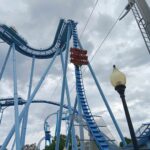 ground 205 feet below before you plummet off the cliff! While I still love the Loch Ness Monster, this one gets a big thumbs up from us both.
ground 205 feet below before you plummet off the cliff! While I still love the Loch Ness Monster, this one gets a big thumbs up from us both.
How about you? Are you a rider? Or a spectator holding the bags? I’d love to hear about your favorite.
